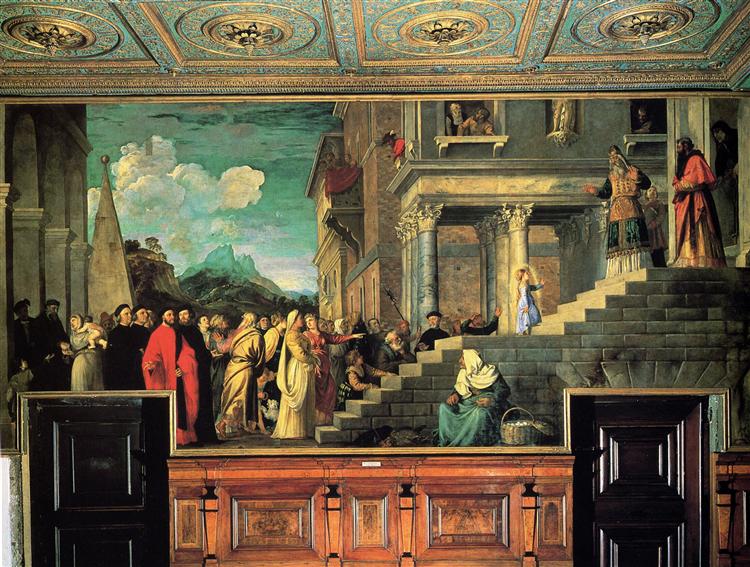Description
The painting "The Entry of Mary into the Temple", painted by Titian in 1538, is one of the monuments of Renaissance art that embodies the Venetian artist's mastery in the representation of colour and light. Titian, known for his innovative approach to the use of colour, employs a vibrant palette here that highlights the central figure of the Virgin Mary, who is portrayed at the moment she is presented in the Temple by her parents, Joachim and Anna. This scene, full of symbolism and emotion, is framed by an architectural setting that recalls the grandeur of the structures of the time.
The first aspect that catches the viewer's attention is the painting's composition. Titian organizes the space so that the figure of Mary instantly becomes the work's center of gravity. The arrangement of the figures around her and the use of architectural space, which hints at a monumental temple, create a sense of movement and direction that guides the viewer's gaze toward the main figure. This compositional approach is a distinctive feature of Titian's style, who often broke with the conventions of classical symmetry, opting for more fluid and natural visual dynamics.
Colour, one of Titian’s signatures, plays a crucial role in the emotionality of the work. The rich and varied palette, combining golden, blue and earthy tones, achieves not only an aesthetic balance but also an atmosphere charged with spirituality. The light illuminates Mary in a special way, highlighting her purity and elevation in an environment where the most intense colours seem to flow between the shadows – a technique that Titian mastered and that would influence later generations of artists.
As for the characters surrounding Mary, we find a series of figures that encompass a diversity of expressions and postures, from joy to solemnity. These characters seem to represent different reactions to the sacred event that is taking place, providing a visual narrative that invites reflection on the importance of this moment in the context of the Virgin's life. Although Mary's parents are central figures, Titian ensures that each of the characters accompanying the scene has their own presence and psychology, which enriches the viewer's experience.
An interesting aspect of “Mary’s Entry into the Temple” is its artistic context. Painted in a period when Titian was considered the most important painter in Venice, the work reflects not only his technical mastery, but also the evolution of Renaissance art into what would become the beginning of the Baroque. His ability to blend the divine and the human is manifest in the way he portrays Mary not just as a religious icon, but as a person of flesh and blood, a young woman walking toward her destiny with confidence and grace.
In the context of the Renaissance, where the search for beauty, narrative and emotion were paramount, Titian transcends these aspirations, achieving a work that is not only visually impressive, but also deeply moving. "Entry of Mary into the Temple" is a clear testament to Titian's genius, his mastery of color and form, and his ability to tell stories through paint, leaving a lasting mark on the landscape of Western art.
KUADROS ©, a famous painting on your wall.
Hand-made oil painting reproductions, with the quality of professional artists and the distinctive seal of KUADROS ©.
Painting reproduction service with satisfaction guarantee. If you are not completely satisfied with the replica of your painting, we will refund 100% of your money.

